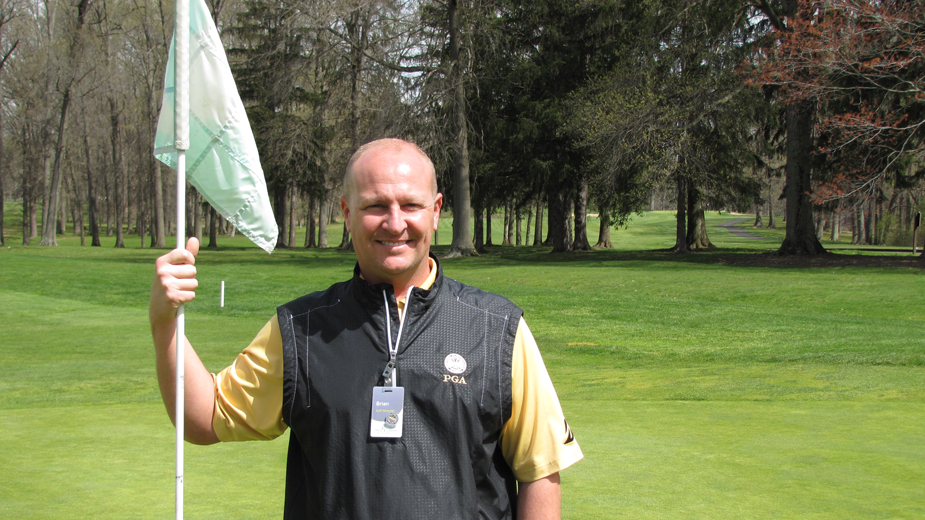Serious Players Double as Ambassadors for Golf
YOUNGSTOWN, Ohio – Golf courses in the Mahoning Valley, along with professionals and coaches, seek new golfers: young people and those who never imagined themselves on the links.
It’s part of their strategy to keep the game of golf – and their businesses – vibrant.
Brian Tolnar, Chris Carfangia, Diane McCall and Jared Wilson are just four of the local ambassadors executing that strategy.
In recent years, the relative lack of younger players and problems marketing the courses have threatened to drive the game into the rough.
In 2016, the National Golf Foundation found that the number of people who played at least one round of golf in the past year fell 1.2% to 23.8 million, the lowest number since Tiger Woods jumpstarted the popularity of the game in the late 1990s.
Locally, more courses have shut down than opened in recent years, including Copeland Hills and Lakefront in Columbiana, Candywood in Vienna and Willow Woods in Hubbard. They are part of the more than 800 courses across the nation that closed in the last decade.
Mill Creek Golf Course in Boardman is one that is bucking the trend by targeting new groups of golfers, says its director of golf, Brian Tolnar.
Millennials, and the demographic after them, sometimes called Centennials, have become valued in the golf world, he says.
“When I got into the game, no one wanted to touch you until you were 12 years old,” Tolnar says of the golf courses and professionals of the time. “Today, we’re getting kids at five, six, seven, eight – before they get tied in with some other sport.”
Those children come with their Millennial parents, who want to comfortably bring their families out for a round, Tolnar emphasizes. That’s a marked contrast from previous generations where fathers dominated the links, whether playing in business outings or with their buddies on weekends.
Making the game more attractive for juvenile golfers is a recommendation of the National Golf Foundation. The number of junior golfers, defined as those between the ages of six and 17 who played at least one round of golf in the previous year, fell from a peak of 4.1 million to the current level of three million, up from a low of 2.4 million in 2011.
Heeding such advice, Mill Creek recently installed kids’ tees on the golf course, making it easier and more comfortable for younger players to learn how to play.
“It is an added expense, but from the children’s perspective it’s huge,” Tolnar says, “and that’s where we want to grow the game.”
The golf course has also instituted the Donald Ross kids club. It offers children rewards such as bag tags and balls and is guided by simple rules of play, something the game has not been known for.
“It’s all about having fun,” Tolnar says of the program.
Among other offerings, Mill Creek has monthly family golf night specials and a collegiate card where students who bring in their college identifications get a discounted rate.
Mill Creek is also attracting Millennials pressed for time and other beginning golfers to the park’s par three golf course.
“We’re unique in that we do have a par three course, and that’s where everyone is gathering,” Tolnar says. “Our numbers there have been great the last couple of years.”
Beginning golfers often start on the driving range, graduate to the par three course and work their way up to playing 18 holes, Tolnar says.
“It’s a great way to get people married into the game at the full-scale level,” he says.
With a variety of activities and programming, Mill Creek’s numbers are rebounding and business is good, Tolnar reports.
The course saw a steady decline in the years during the Great Recession and its aftermath, but numbers have rebounded and are now growing faster than the national average, he says.
“One of the reasons we’ve been successful in the past two years is because we’ve had a lot of activities,” Tolnar says. “We’ve really gotten our staff behind building and growing the game.”
Chris Carfangia, director of golf at Pine Lakes Golf Club in Hubbard, is concentrating on increasing interest in the game by bringing in neophytes and converting what the National Golf Course Owners Association calls a core golfer into an avid golfer. “Every time someone comes out here and says, ‘I brought my buddy, but he doesn’t play very much,’ I really make an effort to make them feel comfortable when they come here.”
 Chris Carfangia is the director of golf at Pine Lakes Golf Club in Hubbard.
Chris Carfangia is the director of golf at Pine Lakes Golf Club in Hubbard.
Carfangia runs clinics, meet-and- greets and something he calls “wine and wedges,” where players can buy a glass of wine and relax as they practice chipping.
“It helps ease the tension and makes it a little more social than athletic,” he says.
This is all part of an atmosphere that Pine Lakes works hard to cultivate, Carfangia says. “We like to keep it fun around here – lighthearted atmosphere, music playing, just generally relaxed.”
With the Get Golf Ready program for beginners, Carfangia takes groups of six to eight out on the course to learn the game.
It helps to reduce social anxiety and allows players to relax and focus on their game, he says.
It also helps draw new players. According to a recent report in The Wall Street Journal, programs such as Get Golf Ready are more likely to retain new golfers.
Carfangia walks students through the basics of golf and guides them through the basics of golf etiquette.
He meets players in the parking lot, explains how to sign up for a tee time and makes rank beginners feel comfortable about walking into a clubhouse.
“A lot of these guys are like, ‘I want to play golf, but what do you do?’ I walk them through it,” Carfangia says.
But it’s not just beginners he’s focused on. Carfangia wants regular golfers to play more as well.
“People will often focus on getting children involved. My job is to take the guy who comes out once a week, 20 times a year, and try to get that person to play twice a week,” he says, “because they spend money.”
But the job of sustaining and nurturing the game isn’t just for professionals, course owners and coaches, Carfangia says. Everyday players can be ambassadors for the game they love.
“If you’re a golfer, your job – at some point in your life – is to get one more person to play golf. If we all did that, the game would be pretty solid for a long time,” he says.
Canfield girls golf coach Diane McCall sees progress in attracting younger golfers to the game. She’s coached more than two decades and is the president of the Northeast Ohio Golf Coaches Association.
“One thing that has been a positive, and continues to be a positive, is the number of high school teams continues to grow in Ohio,” McCall says.
There are 321 girls’ teams in the state and 646 boys’ squads, she says.
In addition to coaching high school golf, McCall works with leagues for girls in the sixth, seventh and eighth grades, which helps them hone their games in preparation for high school golf.
“Introducing young adults to the game at a young age is key,” McCall says. “Usually a girl who is interested in golf had someone in their life along the way who was also interested in golf.”
For those who make it to the high school level, a good coach is essential to keep them playing,” McCall says, and groom them as ambassadors for the sport.
“As coaches, we continue to grow our own high school programs and keep these students interested in the game,” she says, “so hopefully it can continue to be part of their lives as they get older.”
One high school student who doesn’t believe he’ll ever stop playing is Columbiana native Jared Wilson.
Wilson started playing at six and by eight was part of the Drive-Chip & Putt national finals in Orlando, Fla., featured on the Golf Channel.
Today, at 17, he’s an Ohio High School Athletic Association state champion on his way to play collegiate golf at Wake Forest University, which counts Arnold Palmer, Curtis Strange and Lanny Wadkins among its alumni.
Wilson became infatuated during the height of Tiger Woods’ career, when record numbers of players flocked to courses and the popularity of the sport last crested.
 Jason Wilson started playing golf at age six.
Jason Wilson started playing golf at age six.
“People don’t have as much exposure to golf as they used to,” Wilson says. “Golf isn’t some sport like football, baseball or basketball – sports that people seem to be immediately drawn to.”
That’s something he hopes to change.“My success and the state championship has given me a platform to speak to lots of different people about the game,” he says.
Wilson promotes Columbiana High School’s team and has become an ambassador for the game in the Valley and beyond.
Because he’s so serious about golf, Wilson recognizes that the game should be fun.
“When your starting out with any sport, it has to be fun,” he says. “That’s how you get people interested and get them to stay with the game.”
Wilson doesn’t believe that young people pose any special marketing challenge for golf. Once the game is effectively showcased and explained, he believes new golfers will follow.
“It does take a little bit of promoting to get people out on the golf course,” he allows. “Expose people to it. It really is a great game, and once people do experience it, they really enjoy it. But it’s all about getting that initial exposure.”
Pictured at top: Brian Tolnar is the director of golf at Mill Creek Golf Course in Boardman.
Copyright 2024 The Business Journal, Youngstown, Ohio.



